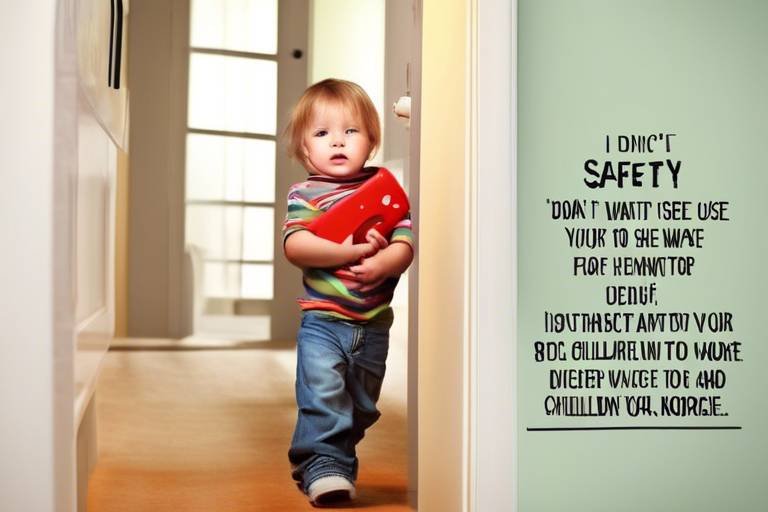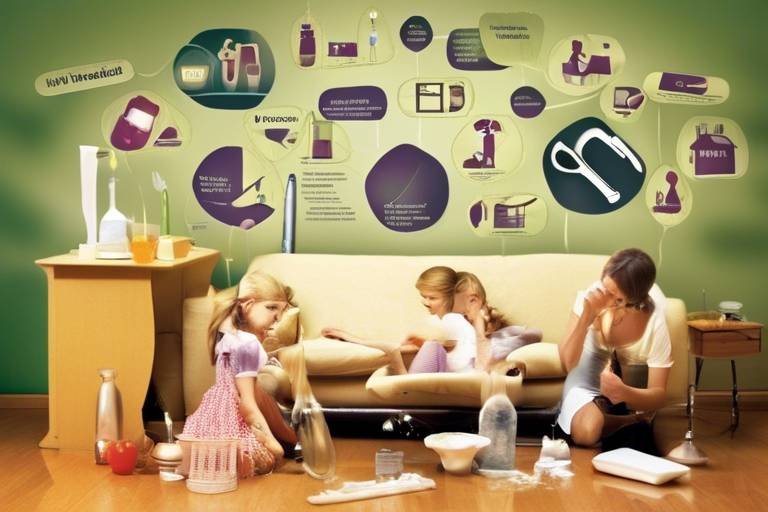Active Play: A Key to a Child’s Good Health
In today’s fast-paced world, where screens dominate our daily lives, the importance of active play for children cannot be overstated. Active play is not just about having fun; it is a crucial component of a child's overall health and development. Imagine a world where children are not only physically fit but also emotionally balanced and socially adept, all thanks to the simple act of playing. This article delves into the myriad benefits of active play, showcasing how it lays the groundwork for a healthy lifestyle and a happier mindset.
Physical activity is vital for children's growth and development. It helps build strong bones and muscles, improves cardiovascular fitness, and supports healthy weight management, laying the foundation for lifelong health. Regular physical activity is essential for children, as it not only aids in physical development but also enhances their mental health. Just think about it: when kids run, jump, and play, they’re not just burning off energy; they’re also cultivating their bodies and minds for the challenges ahead.
Active play offers numerous benefits, including enhanced motor skills, improved coordination, and increased social interaction. Engaging in play also fosters creativity and problem-solving skills, crucial for cognitive development. When children engage in active play, they are not just moving their bodies; they are also learning to navigate the world around them. For instance, a game of tag teaches them about speed and strategy, while building a fort encourages teamwork and imagination.
Active play contributes significantly to children's emotional health. It allows them to express feelings, manage stress, and build resilience, promoting a positive self-image and emotional intelligence. Have you ever noticed how a simple game can lift a child's spirits? When children play, they experience joy, excitement, and even the occasional frustration, all of which are essential for emotional growth. Through play, they learn to cope with challenges and celebrate victories, fostering a sense of well-being.
Through active play, children learn essential social skills such as teamwork, communication, and conflict resolution. These interactions help them form friendships and navigate social situations effectively. Picture a group of kids playing soccer; they must communicate, strategize, and sometimes deal with disagreements. These experiences are invaluable as they prepare children for real-life social dynamics. The playground becomes a training ground for life’s bigger challenges.
Participating in active play helps children gain confidence in their abilities. Mastering new skills during playtime encourages a sense of achievement and motivates them to take on new challenges. Whether it's climbing to the top of the jungle gym or scoring a goal in a game, each small victory boosts their self-esteem. It’s like a stepping stone; each successful experience builds a bridge to greater confidence and resilience.
Engaging in active play enhances cognitive development by stimulating brain function. Activities that require strategic thinking and problem-solving improve focus, attention span, and overall academic performance. Think of it this way: when children are involved in games that challenge their minds and bodies, they are essentially giving their brains a workout. This not only enhances their learning capabilities but also prepares them for academic success.
Parents can foster a love for active play by creating a safe and stimulating environment. Simple strategies, such as limiting screen time and providing diverse play options, can promote physical activity. Consider transforming your backyard into a mini playground or setting up indoor activities that encourage movement. It’s all about making play accessible and exciting!
Encouraging outdoor play is essential for children's health. Activities like biking, climbing, and playing sports not only provide exercise but also connect children with nature, enhancing their overall well-being. Here are a few ideas to get started:
- Biking: A fun way to explore the neighborhood.
- Climbing: Whether it's trees or playground equipment, climbing builds strength.
- Playing Sports: Team sports teach cooperation and discipline.
When outdoor play isn't possible, indoor activities can keep children active. Options like dance parties, obstacle courses, and interactive games can ensure they remain engaged and physically active. Think about turning your living room into a dance floor or setting up a mini obstacle course using cushions and furniture. The possibilities are endless, and the goal is to keep the fun rolling, regardless of the weather!
Q: How much active play should children engage in daily?
A: The general guideline is at least 60 minutes of physical activity each day for children, which can be broken up into shorter segments.
Q: What types of play are best for promoting health?
A: A mix of structured activities (like sports) and unstructured play (like free play) is ideal for promoting health and development.
Q: How can I motivate my child to be more active?
A: Lead by example, make it fun, and incorporate activities that your child enjoys. Keeping a variety of options available can spark their interest!

The Importance of Physical Activity
Physical activity is not just a buzzword; it’s a crucial element in the holistic development of children. Think of it as the fuel that powers their growth engines. Regular movement helps children build strong bones and muscles, which are essential for their overall health. When kids engage in active play, they’re not just having fun; they’re laying down the groundwork for a lifetime of healthy habits. It’s like planting seeds in a garden—the more you nurture them, the more they flourish.
Moreover, physical activity plays a vital role in improving cardiovascular fitness. Just like how a car needs regular maintenance to run smoothly, children’s hearts and lungs benefit from consistent exercise. When kids run, jump, and play, their hearts pump stronger, and their lungs expand, enhancing their overall stamina and endurance. This is especially important as they grow and face the demands of school, sports, and other activities.
Another significant aspect of physical activity is its role in supporting healthy weight management. In a world where sedentary lifestyles are becoming the norm, encouraging kids to be active can help combat obesity and its related health issues. It’s not just about looking good; it’s about feeling good from the inside out. Regular play helps balance energy intake and expenditure, ensuring that children maintain a healthy weight.
It's also important to note that the benefits of physical activity extend beyond just the physical realm. When children engage in active play, they also develop social skills and emotional resilience. They learn to work as a team, communicate effectively, and navigate conflicts—skills that are invaluable as they grow up. So, while they may be running around and laughing, they’re also building a toolkit for life.
In summary, physical activity is essential for children's growth and development. It builds strong bones and muscles, improves cardiovascular fitness, and supports healthy weight management. By encouraging active play, parents and caregivers can help children establish a foundation for lifelong health and well-being. Remember, every little bit counts! Whether it’s a game of tag in the backyard or a family hike on the weekend, the important thing is to keep those little bodies moving.

Benefits of Active Play
Active play is not just a fun way for children to spend their time; it’s a crucial component of their overall development. Think of it as the secret ingredient in a recipe for healthy growth! When children engage in active play, they are not only burning off energy but also reaping a multitude of benefits that extend beyond the playground. From enhancing physical abilities to boosting emotional and social skills, the advantages are profound and far-reaching.
One of the most significant benefits of active play is the improvement of motor skills. As children run, jump, and climb, they are honing their coordination and balance. These activities help them develop the fine and gross motor skills necessary for everyday tasks, such as writing or playing a musical instrument. Imagine a child mastering a tricky balance beam; that moment of triumph not only builds their physical capability but also sparks a sense of accomplishment.
Moreover, active play fosters social interaction. When kids engage in group games, they learn to communicate, cooperate, and even negotiate with their peers. These interactions are vital for developing friendships and understanding the dynamics of teamwork. Picture a group of children working together to build a fort—each child contributes their ideas, learns to listen, and experiences the joy of collaboration. Such moments are invaluable in teaching them how to navigate the social world.
In addition to physical and social benefits, active play significantly contributes to emotional well-being. It provides children with a safe outlet to express their feelings and manage stress. Whether they are playing tag or engaging in imaginative role-play, children often channel their emotions through active play. This process helps them build resilience and a positive self-image. Think of active play as a natural stress reliever; it allows kids to blow off steam and return to their daily lives feeling refreshed and more balanced.
Furthermore, active play ignites creativity and enhances problem-solving skills. When children engage in imaginative play, they are not just having fun; they are also exercising their brains. Activities that require them to think strategically—like organizing a game of capture the flag or building a complex structure with blocks—encourage cognitive development. They learn to plan, adapt, and overcome challenges, skills that are essential in both academic and real-world settings.
In summary, the benefits of active play are multifaceted and essential for a child’s growth. It’s not merely about getting kids to run around; it’s about nurturing their physical, emotional, and social health. By encouraging active play, parents and caregivers are investing in their children's future, equipping them with the skills they need to thrive in a complex world.
- What types of activities count as active play? Any physical activity that gets children moving, such as running, jumping, dancing, or playing sports, qualifies as active play.
- How much active play do children need? Experts recommend that children engage in at least 60 minutes of active play each day to support their health and development.
- Can indoor play be just as beneficial as outdoor play? Yes! Indoor activities like dancing, obstacle courses, and interactive games can also provide significant physical benefits.

Emotional Well-being Through Play
Active play is not just about physical exertion; it plays a crucial role in nurturing emotional well-being in children. Think of play as a magical gateway where kids can express their feelings freely, much like how a painter uses colors to express emotions on canvas. When children engage in play, they often channel their thoughts and emotions, allowing them to process experiences that might otherwise feel overwhelming. This process is vital for their emotional growth.
One of the most significant advantages of active play is its ability to help children manage stress. Just like adults, children face pressures, whether it's from school, friendships, or family dynamics. Through play, they can let off steam and release pent-up energy, transforming stress into joy. Imagine a child running around in a park, laughter echoing as they chase friends—this simple act is a powerful stress reliever!
Moreover, active play fosters resilience. When children face challenges during play—like climbing a tree or mastering a new game—they learn to navigate failures and successes. These experiences teach them that it's okay to stumble; what matters is getting back up and trying again. This resilience translates into real-life situations, equipping them with the tools to handle life's ups and downs.
Active play also promotes a positive self-image. When children engage in activities that require skill, they often experience a sense of achievement. This boost in confidence can be likened to planting seeds in a garden; with time and nurturing, those seeds blossom into beautiful flowers. Similarly, children who feel good about their abilities are more likely to take on new challenges, whether in sports, academics, or personal relationships.
To summarize, the emotional benefits of active play are profound and multifaceted. Here’s a quick rundown:
- Expression of Feelings: Play provides a safe space for children to express their emotions.
- Stress Management: Physical activity helps reduce anxiety and stress levels.
- Building Resilience: Facing challenges during play teaches children how to cope with setbacks.
- Enhancing Self-esteem: Mastering new skills boosts confidence and encourages further exploration.
In conclusion, active play is a vital ingredient in the recipe for a child's emotional health. By encouraging our little ones to play actively, we are not just promoting physical fitness; we are also nurturing their emotional intelligence and resilience, setting them up for a brighter, more balanced future.
Q: How does active play impact a child's emotional health?
A: Active play allows children to express their feelings, manage stress, and build resilience, all of which contribute to better emotional health.
Q: What types of play are best for emotional well-being?
A: Both outdoor and indoor active play are beneficial. Activities that encourage creativity, teamwork, and problem-solving are particularly effective.
Q: How can parents encourage more active play?
A: Parents can limit screen time, provide a variety of play options, and create a safe environment for children to explore and engage in physical activities.

Social Skills Development
Active play is not just about running around or kicking a ball; it’s a powerful tool for developing social skills in children. When kids engage in play, they're not only having fun but also learning how to interact with others in meaningful ways. Imagine a group of children playing tag—it's not just a game of speed; it's a masterclass in communication, teamwork, and even conflict resolution. Through these interactions, children learn to express their feelings, negotiate rules, and understand the perspectives of their peers.
During play, kids often encounter situations that require them to work together towards a common goal. For instance, when building a fort or playing a team sport, they must communicate effectively, share resources, and support each other. This collaborative effort helps them develop essential social skills, such as:
- Teamwork: Learning to work with others towards a shared objective.
- Communication: Understanding how to express thoughts and feelings clearly.
- Conflict Resolution: Navigating disagreements and finding solutions amicably.
Moreover, through active play, children also learn to read social cues and body language, which are crucial for building relationships. When they see a friend frown or cross their arms, they begin to understand that something might be wrong, prompting them to check in or offer support. This level of empathy is vital for developing emotional intelligence, which plays a significant role in their future interactions.
As parents and caregivers, encouraging playtime is key to fostering these invaluable skills. Whether it's through organized sports, cooperative games, or simply unstructured playtime with peers, the opportunities for learning are endless. So, the next time you see your child playing, remember that they are not just having fun—they are also building a solid foundation for their social future.
Q: How can I encourage my child to engage in more active play?
A: Start by limiting screen time and providing a variety of play options. Encourage outdoor activities and join in the fun to motivate them.
Q: What types of play are best for developing social skills?
A: Group activities like team sports, cooperative games, and role-playing scenarios are excellent for fostering teamwork and communication.
Q: How can I support my child's emotional development through play?
A: Engage in conversations about their play experiences, encourage them to express their feelings, and help them navigate social interactions with peers.

Building Confidence
Building confidence in children is one of the most rewarding aspects of engaging in active play. When kids participate in various activities, they encounter challenges that require them to step out of their comfort zones. Imagine a child learning to ride a bike for the first time; the initial wobbles and falls might seem daunting, but with each attempt, they gain not just balance but also a sense of accomplishment. This journey from uncertainty to mastery is crucial for their self-esteem.
Active play provides countless opportunities for children to develop their confidence. For instance, when they successfully complete a challenging obstacle course or score a goal in a game, they experience a rush of pride. This feeling reinforces their belief in their abilities, encouraging them to take on new challenges. It’s like planting seeds of self-assurance that will grow over time. Each small victory, whether it’s learning a new skill or making a new friend during play, contributes to a stronger self-image.
Moreover, the social aspect of active play cannot be overlooked. When children engage in team sports or group activities, they learn to communicate and collaborate with others. These interactions not only build friendships but also teach them how to navigate social dynamics. For example, working together to win a game fosters a sense of belonging and acceptance, which is vital for developing a confident personality. Children learn that they are valued members of a team, boosting their self-worth.
To further illustrate the impact of active play on confidence, consider the following scenarios:
- Mastering New Skills: Whether it’s climbing a tree or learning to swim, each new skill mastered during play reinforces the child’s belief that they can achieve their goals.
- Encouraging Risk-Taking: Active play encourages children to take calculated risks, such as trying a new sport or performing in front of others, which builds resilience and self-assurance.
- Positive Feedback: When parents and peers celebrate their achievements, it further solidifies their confidence and motivates them to keep trying.
In conclusion, active play is not just about physical activity; it’s a powerful tool for building confidence in children. By creating opportunities for them to explore, learn, and succeed, we are laying the groundwork for a generation of confident, resilient individuals ready to take on the world. So, let’s encourage our kids to play actively, embrace challenges, and watch their self-confidence soar!
Q: How can I encourage my child to engage in more active play?
A: Start by setting aside dedicated playtime each day. Explore various activities together, such as biking, playing tag, or visiting a playground. Make it fun and engaging to spark their interest!
Q: What if my child prefers indoor activities?
A: Indoor play can be just as active! Consider dance parties, building obstacle courses, or interactive video games that promote movement. The key is to keep them engaged and moving.
Q: How does active play affect my child's academic performance?
A: Engaging in active play improves focus, attention span, and cognitive function, all of which contribute positively to a child’s academic performance.

Cognitive Benefits of Active Play
Active play is not just about burning off energy; it's a powerhouse for cognitive development. When children engage in play that requires movement, they are also engaging their brains in ways that can significantly enhance their mental capabilities. Think of it like a workout for the brain! Just as physical exercise strengthens muscles, active play stimulates brain function, making it more agile and responsive.
During active play, children are often faced with challenges that require strategic thinking and problem-solving skills. For example, when playing tag, a child must quickly decide which direction to run, how to evade others, and sometimes even how to strategize with friends to win the game. These decisions, made in the heat of the moment, are not just fun; they are also training the brain to think on its feet.
Research has shown that children who participate in regular active play exhibit improved focus and attention span. This is crucial for their academic performance, as a child who can concentrate better is more likely to absorb and retain information in the classroom. Furthermore, the physical exertion associated with active play helps to reduce stress and anxiety, which can be significant barriers to learning. When kids feel good physically, they are more likely to feel good mentally!
Here are some cognitive benefits of active play:
- Enhanced Memory: Activities that involve movement can improve memory retention. For instance, a child who plays a game that requires them to remember a series of actions is exercising their memory skills.
- Increased Creativity: Active play often involves imaginative scenarios, whether it’s pretending to be superheroes or creating obstacle courses. This fosters creative thinking and innovation.
- Better Academic Performance: Studies have indicated that children who engage in regular physical activity tend to perform better academically, as they are more engaged and alert during lessons.
Moreover, active play can also enhance social cognition. When children play together, they learn to read social cues, understand others’ perspectives, and practice empathy. This is particularly important in developing emotional intelligence, which is just as critical as cognitive skills in today's world. So, the next time your child is running around, know that they are not just having fun; they are also laying the groundwork for a sharper, more capable mind!
Q1: How much active play should children engage in daily?
A1: The CDC recommends that children engage in at least 60 minutes of physical activity each day. This can include various forms of active play, such as sports, dancing, or simply running around outdoors.
Q2: What types of active play are best for cognitive development?
A2: Activities that involve strategy, teamwork, and problem-solving are particularly beneficial. Games like tag, hide and seek, or team sports encourage children to think critically and make quick decisions.
Q3: Can indoor play also contribute to cognitive benefits?
A3: Absolutely! Indoor activities like obstacle courses or interactive video games that require movement can also stimulate cognitive development. The key is to keep them engaging and physically active.

Encouraging Active Play at Home
Creating an environment that promotes active play at home is essential for children's physical and emotional development. It's not just about letting them run around; it's about fostering a culture of movement and fun that encourages them to be active. Parents and caregivers can play a pivotal role in this by being proactive and creative. For instance, consider transforming your living room into a mini obstacle course. Use cushions, chairs, and blankets to create a safe yet challenging environment where kids can climb, jump, and crawl. This not only keeps them physically engaged but also sparks their imagination.
Another effective strategy is to limit screen time. With the rise of technology, children are often glued to screens for entertainment. By setting clear boundaries on screen usage, you can encourage them to seek out more active forms of play. Think of it as a way to reclaim their time for activities that fuel their energy and creativity. Instead of watching a show, why not challenge them to a dance-off or a game of tag in the backyard? These activities can be not only fun but also serve as an excellent workout.
Additionally, providing a variety of play options is crucial. Children are more likely to engage in active play if they have different activities to choose from. Here are some ideas:
- Sports equipment like balls, jump ropes, and hula hoops
- Art supplies for creative outdoor projects
- Gardening tools to encourage outdoor exploration
By offering these options, you can cater to their interests and keep them engaged. Remember, the goal is to make active play a natural part of their daily routine, not just an occasional event.
Moreover, involving the whole family in active play can be incredibly beneficial. Family game nights that include physical activities—like charades or scavenger hunts—can strengthen bonds while promoting health. Imagine the laughter and joy as everyone participates, each person bringing their unique energy to the table. It’s a win-win situation: you get to spend quality time together, and your children get the exercise they need.
Lastly, don’t forget the power of nature. If possible, take your children outside regularly. Parks, hiking trails, and even your backyard can serve as fantastic venues for active play. Nature has a way of invigorating children, making them more likely to engage in physical activities. Plus, being outdoors can enhance their mood and stimulate their senses, making playtime even more enjoyable.
Q: How much active play should children get each day?
A: Ideally, children should aim for at least 60 minutes of active play each day. This can include a mix of structured activities and free play.
Q: What if my child prefers indoor activities?
A: Indoor play can be just as active! Encourage activities like dance parties, yoga, or even interactive video games that promote movement.
Q: How can I motivate my child to be more active?
A: Lead by example! Join them in activities, set challenges, and celebrate their achievements to keep them motivated.

Outdoor Play Ideas
Encouraging outdoor play is essential for children's health and well-being. Imagine a world where children can run freely, their laughter echoing through parks, and their imaginations soaring as high as the trees they climb. Outdoor play is not just about physical activity; it’s a gateway to adventure and discovery. When children engage in activities like biking, climbing, or playing sports, they not only get the exercise they need but also connect with nature, which is crucial for their overall development.
One fantastic way to inspire outdoor play is to create a playful environment. This can be as simple as setting up a safe area in your backyard or visiting local parks. Here are some engaging outdoor activities that can make playtime exciting:
- Biking: Riding a bike is a thrilling way to explore the neighborhood. It builds strength and endurance while allowing children to experience the joy of speed.
- Climbing: Whether it’s climbing trees, playground structures, or even a rock wall, climbing helps develop physical strength and coordination.
- Sports: Organizing games like soccer, basketball, or tag fosters teamwork and friendly competition, teaching kids valuable social skills.
- Nature Scavenger Hunts: Create a list of items for children to find in the park, like specific leaves, rocks, or flowers. This activity not only keeps them active but also encourages curiosity about their environment.
Moreover, incorporating elements of creativity into outdoor play can make it even more enjoyable. For example, setting up a mini obstacle course using household items or natural elements can challenge children physically and mentally. They can jump over sticks, crawl under tables, or balance on logs. This not only enhances their motor skills but also keeps the play fresh and exciting.
Another great idea is to organize community events, like a family sports day or a neighborhood picnic. These gatherings not only promote physical activity but also strengthen community bonds. Children can learn from each other, make new friends, and develop a sense of belonging, all while being active.
In summary, outdoor play is a vital component of a child's development. It nurtures their physical, emotional, and social well-being. By providing opportunities for engaging outdoor activities, parents can help their children thrive in a world filled with adventure and growth.
Q1: How much outdoor play is recommended for children?
A1: The American Academy of Pediatrics recommends that children should engage in at least 60 minutes of physical activity each day, which can include outdoor play.
Q2: What if my child prefers indoor activities?
A2: It’s important to balance indoor and outdoor play. Encourage outdoor activities by making them fun and inviting, such as organizing playdates or family outings.
Q3: Are there specific outdoor activities for different age groups?
A3: Yes! Younger children might enjoy simple games like tag or hide and seek, while older children can engage in sports or more complex activities like hiking or biking.
Q4: How can I ensure my child’s safety during outdoor play?
A4: Always supervise your child during outdoor activities, ensure they wear appropriate safety gear, and choose safe environments for play.

Indoor Play Activities
When the weather outside is less than inviting, it’s essential to have a treasure trove of ready to keep your little ones active and engaged. Just because the sun isn’t shining doesn’t mean the fun has to stop! Indoor play can be just as beneficial as outdoor play, providing kids with the opportunity to burn off energy, enhance their motor skills, and foster creativity. So, what are some exciting ways to keep the momentum going when you’re stuck inside?
One fantastic idea is to set up a mini obstacle course right in your living room. You can use cushions, chairs, and blankets to create tunnels, jumps, and balance beams. This not only gets the heart pumping but also challenges their coordination and agility. Just imagine your child navigating through this makeshift course like a little ninja!
Another great way to encourage active play indoors is through dance parties. Put on some upbeat music and let your kids dance like nobody's watching. This is an excellent way for them to express themselves while also getting a good workout. You can even turn it into a game by incorporating dance challenges, where they have to mimic your moves or create their own. It’s a win-win for fun and fitness!
For those days when you need a little structure, consider setting up interactive games that require movement. Games like Simon Says or Musical Chairs can be adapted to fit any space and are sure to get everyone involved. These games not only get kids moving but also teach them about listening skills and following directions.
Here’s a quick table summarizing some indoor play activities along with their benefits:
| Activity | Benefits |
|---|---|
| Obstacle Course | Improves coordination, agility, and strength |
| Dance Party | Enhances cardiovascular fitness and self-expression |
| Interactive Games (e.g., Simon Says) | Boosts listening skills and encourages teamwork |
Moreover, you can also create themed play sessions. For instance, a “space adventure” could involve pretending to be astronauts exploring the universe, where they have to jump from planet to planet (cushions) and dodge asteroids (soft balls). This kind of imaginative play not only keeps them active but also sparks their creativity.
Lastly, don’t underestimate the power of simple household items. Turn a hallway into a bowling alley with empty plastic bottles and a soft ball. Or, create a scavenger hunt that requires them to move around the house, searching for items on a list. These activities are not only entertaining but also help develop problem-solving skills.
In conclusion, indoor play activities are a vital part of keeping children physically active, especially when outdoor options are limited. By incorporating fun and creative ideas, you can ensure that your kids remain engaged, active, and happy, even when they can't step outside. Remember, the key is to make it enjoyable and to encourage them to explore their environment in new and exciting ways!
- How much indoor playtime is recommended for children? It's generally suggested that children should have at least 60 minutes of physical activity each day, which can include both indoor and outdoor play.
- What are some other indoor activities for kids? Besides the ones mentioned, you can also try yoga, balloon volleyball, or creating a homemade gym with simple exercises.
- Can indoor play be educational? Absolutely! Many indoor activities can incorporate learning, such as counting during games or using play to teach problem-solving skills.
Frequently Asked Questions
- Why is active play important for my child's health?
Active play is crucial for children's physical, emotional, and social well-being. It helps them develop strong bones and muscles, improves cardiovascular fitness, and supports healthy weight management. Plus, it lays the groundwork for a lifetime of healthy habits!
- What are the benefits of active play?
Active play provides numerous benefits, such as enhanced motor skills, improved coordination, and increased social interaction. It also fosters creativity and problem-solving skills, which are essential for cognitive development.
- How does active play contribute to emotional well-being?
Active play allows children to express their feelings, manage stress, and build resilience. This helps them develop a positive self-image and emotional intelligence, which are vital for their overall mental health.
- Can active play help my child develop social skills?
Absolutely! Through active play, children learn essential social skills such as teamwork, communication, and conflict resolution. These interactions not only help them form friendships but also teach them how to navigate social situations effectively.
- How can I encourage active play at home?
Creating a safe and stimulating environment is key! Limit screen time and provide diverse play options. Simple strategies like setting up playdates or providing outdoor equipment can significantly promote physical activity.
- What are some fun outdoor play ideas?
Outdoor play is essential for children's health! Activities like biking, climbing, playing sports, or even just running around can provide great exercise while connecting them with nature, enhancing their overall well-being.
- What indoor activities can keep my child active?
When outdoor play isn't an option, there are plenty of exciting indoor activities! Consider dance parties, obstacle courses, or interactive games to keep your child engaged and physically active, even when stuck inside.



















